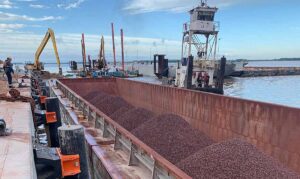The Port of Prince Rupert provides a Canadian trade alternative to the worldwide market access challenge due to its strategic place, operational efficiency and wide reach.
In increasing Asian economies, Ridley Coal Terminal transports metallurgical coal for steel production.
In North Africa, the Middle East and the Americas, Prince Rupert Grain moves wheat and barley for food production. Westview Terminal carries pellets of wood for use in Europe and elsewhere as biofuels.
The Port of Prince Rupert offers ready access to the natural resource manufacturers and exporters of Western Canada.

The network of CN in BC and the Prairies offers one-line access to the Port from mines and fields and forests. As manufacturers continue to look westward to increasing Pacific markets, Prince Rupert offers a strategic export route for bulk commodities from BC, Alberta, Saskatchewan and Manitoba.
The gateway’s fluidity is part of what makes Prince Rupert an optimal destination to export bulk commodities.
Prince Rupert’s northern mainline from CN prevents urban congestion and guarantees quickly, smooth cargo transit to the terminals.
Port terminals and workers are world productivity leaders, ensuring that products are transferred from rail to vessels at major efficiency levels in the sector.
The Port Authority of Prince Rupert
The Port Authority of Prince Rupert (PRPA) is a port authority functioning as an independent and commercially feasible organization under the Canada Marine Act. PRPA is responsible for all federally owned waterfront properties on Prince Rupert Harbour, situated in and around the North Coast of British Columbia town of Prince Rupert.
The PRPA was established on May 1, 1999, following the Prince Rupert Port Corporation (PRPC). As required by the Canada Marine Act passed on June 11, 1998, Prince Rupert was one of eight national ports in Canada that implemented this administrative change on that date. PRPC was the successor to the National Harbors Board, which earlier operated all Canadian ports owned by the federal government.
PRPA reports to the Transport Minister and has a board of directors typically made up of local business and community figures. In the past, the process of appointing port authorities of Canada boards has been criticized because they have often been used for political patronage.








